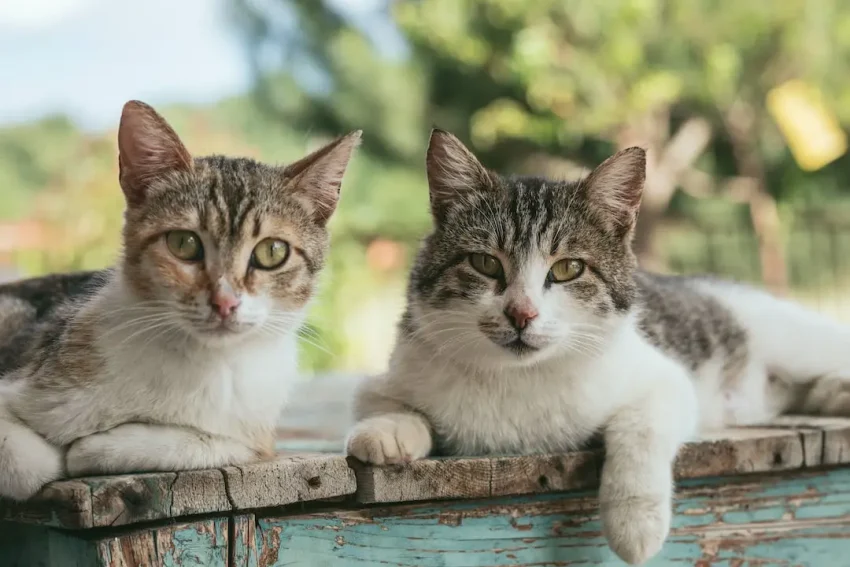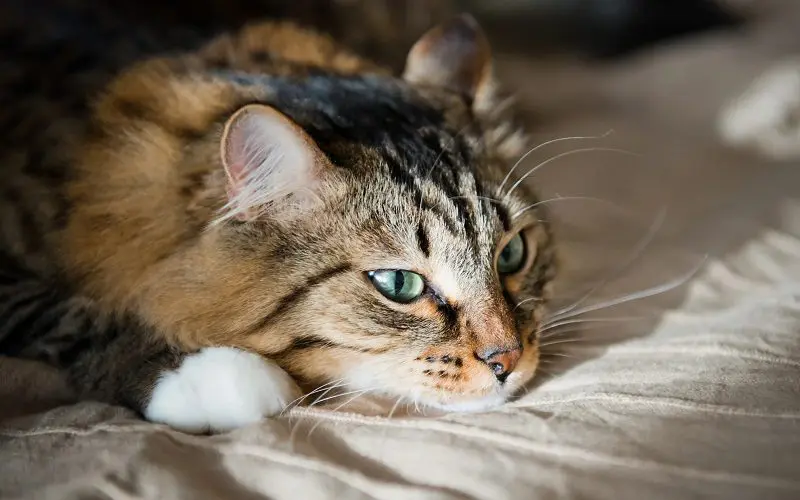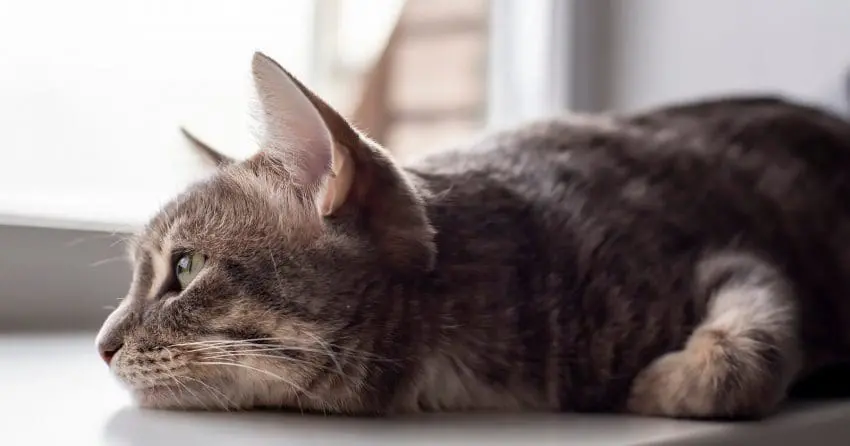Last Updated: 4 months ago
Of all the strange cat behaviors, this is probably the oddest, right? It’s just so human!
Read on to learn why our feline friends do it and whether you should worry.
Why does my cat bite her nails? While nail-baiting is a bad habit for people, it’s a normal grooming routine for cats.
However, if your cat is doing it aggressively to the point where they even hurt themselves, there may be an underlying medical issue.
It could also be a result of injuries, behavioral issues, or stress-related issues.
Normal Nail Biting

Cats occasionally bite, chew, or lick their nails to remove litter, dirt, and any other debris that may be stuck in the nails.
Your cat also bites her nails to trim them. A cat’s claws comprise layers. And over time, the outer layer gets worn out, and the cat will chew this layer for the “new” nails to emerge.
They’ll also chew on their nails to eliminate any remaining pieces in case the nails break.
Some cats may hide or look for a more comfortable place to groom, while others may groom wherever they want to. It all depends on the cat breed you have.
Cats can maintain their nails at a desirable length without chewing, but only if they can find areas to scratch. You can set up several scratching posts around the house.
It would help if you purchased vertical, horizontal, or wall-mounted scratching surfaces to ensure your cat doesn’t get bored.
When cats can’t scratch, their nails may grow too long, making it difficult for them to walk.
Abnormal Nail Biting (4 Reasons)
Excessive grooming in cats can be a result of the following reasons:
1. Behavioral Issues
According to Dr. Nicholas Dodman, author of the book The Cat Who Cried for Help and a pet behavior expert, abnormal chewing is at times caused by anxiety or boredom.
It’s even common for some people to chew their nails when they’re anxious.
Some of the behavioral disorders in cats can be caused by or be the result of the following:
- Loneliness
- Introduction to a new environment
- The presence of other animals (See explanation below)
- Changing the cat’s food
- Pica
2. The presence of other animals

This could be other pets in your house or wild animals.
For instance, if an indoor cat sees a squirrel through the window and there’s nothing she can do to get outside, she may resort to biting her nails.
They even don’t have to see the animal. The animal’s smell is enough to freak them out.
3. What is PICA?
This is where cats crave non-food items. Over-grooming is a symptom of pica.
Other symptoms include cat chewing on wood, metal, and even wool.
Pica is often a response to compulsive behavior disorders and medical conditions such as dental issues or a mineral deficiency.
4. Medical Issues

Infections
Dr. Dodman states that if you notice nail-biting in cats, they may have an infection on the nails.
These could be bacterial infections, yeast infections, or a genetic predisposition.
For instance, Persian cats inherit skin disease, and they may bite their nails to relieve the pain and discomfort.
According to Dr. Carlo Siracusa, your cat may also be reacting to chemicals like bleach that may irritate its paws. Older cats may also develop cancerous tumors or exhibit abnormal levels of growth.
So they may resort to nail chewing to ease the discomfort or trim the long nails.
If you cut the nails too short, their paws may be more susceptible to infection since the blood vessels are exposed.
Parasites
If your cats are affected by parasites such as ringworms, mange mites, or fleas, they may aggressively chew on their nails.
Fleas cause itching skin, constant licking, and nibbling, leading to hair loss, skin redness, and inflammation.
Fleas can also cause skin allergies or even transfer other parasites to your cats.
In a worst-case scenario, they’ll also cause severe blood loss, which leads to anemia. Anemia could also lead to organ failure and even death.
On the other hand, ringworms cause infections in the claws, hair loss, dandruff, scratching, and excessive grooming.
Pemphigus Foliaceous
This is an autoimmune skin disease often found in cats. It causes lesions in the toenail beds and ulcers in sensitive areas of a cat’s body.
These include the eyes, nose, paw pads, ears, and groin.
A veterinarian can help diagnose and treat pemphigus in cats, but don’t try to treat it on your own without a diagnosis.
How to Prevent Your Cat from Biting Her Nails
Here are some tips:
Visit the Veterinarian

When nail chewing is accompanied by symptoms such as redness, lesions, scabs, hair loss, or even bleeding, you need to rush your cat to a veterinarian.
They’ll help diagnose why your cat is biting her nails and suggest the best ways to help her quit the habit.
For instance, some behavioral issues may require some calming or anti-anxiety medication.
But the veterinarian can also recommend a pet behaviorist for behavior modification.
Below are some resources to help you find a professional:
- American College of Veterinary Behaviorists
- Certified Applied Animal Behaviorists
- American Veterinary Society of Animal Behaviorists (AVSAB)
Deal With the Anxiety

Below are some of the ways to reduce anxiety for your cat:
Maintain a constant routine
Cats love being in a routine. It helps them look forward to that activity, and they’ll be less anxious.
For example, feed them at the same time daily. Or schedule some time daily to play with or cuddling with the cat.
If you’ll be away for some time, you can leave your cat with mental stimulation toys such as puzzles and cat treat dispensers to keep them entertained.
Reduce Stress
First of all, diagnose why your cat is feeling stressed.
If there’s a scary dog in the neighborhood, make sure your cat can access your house or another safe place when she needs to.
For instance, you can consider a tall cat tree since dogs can’t really climb on these trees.
If there’s a cat within your household that takes her food, feed her in her own space, and make sure the other cat won’t ambush her.
Cats also don’t like sharing, so always strive to have a tray per cat.
Observe your cat
If your cat is responding to a change of food, try re-introducing the old food and gradually introducing the new food.
If she’s anxious because you moved houses, create her a safe room with all the toys, litter trays, feeding bowls, and everything she needs.
Then introduce her to the rest of the house gradually. If she’s scared of other cats or an animal that comes close to the window, cover the windows with curtains.
And shoo the other animals away when they get too close to your windows.
When you’re busy with your activities and your cat starts nail-biting, you can distract her with some playtime or an interactive toy.
Wrapping Up
If the vet rules out any medical conditions, it’s your job to help the cat quit this bad habit. Sometimes, it may feel like a trial-and-error method.
But with the tips I gave above, as well as recommendations from a pet behaviorist, you’ll have a better chance.
Does your cat bite her nails? Share your experience below!


Olfa knows how to get things done and has a keen business sense that others admire. She’s always on the go, coming up with new ideas! Her ability to anticipate the needs of her readers and deliver information that they want is what makes CatVills such a success. She loves cuddling her cat Picaciu. He is her inspiration.
